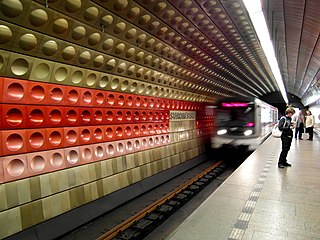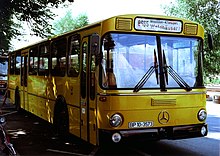
The Deutsche Bahn AG is the national railway company of Germany, and a state-owned enterprise under the control of the German government. Headquartered in the Bahntower in Berlin, it is a joint-stock company (AG).

The Swiss rail network is noteworthy for its density, its coordination between services, its integration with other modes of transport, timeliness and a thriving domestic and trans-alp freight system. This is made necessary by strong regulations on truck transport, and is enabled by properly coordinated intermodal logistics.

The Austrian Federal Railways, now commonly known as ÖBB, is the national railway company of Austria, and the administrator of Liechtenstein's railways. The ÖBB group is owned entirely by the Republic of Austria, and is divided into several separate businesses that manage the infrastructure and operate passenger and freight services.

A Travelling Post Office (TPO) was a type of mail train used in Great Britain and Ireland where the post was sorted en route.
Reichspost was the name of the postal service of Germany from 1866 to 1945.

An intercity bus service or intercity coach service, also called a long-distance, express, over-the-road, commercial, long-haul, or highway bus or coach service, is a public transport service using coaches to carry passengers significant distances between different cities, towns, or other populated areas. Unlike a transit bus service, which has frequent stops throughout a city or town, an intercity bus service generally has a single stop at one location in or near a city, and travels long distances without stopping at all. Intercity bus services may be operated by government agencies or private industry, for profit and not for profit. Intercity coach travel can serve areas or countries with no train services, or may be set up to compete with trains by providing a more flexible or cheaper alternative.

Swiss Post is the national postal service of Switzerland. A public company owned by the Swiss Confederation, it is the country's second largest employer with about 54,000 employees. The group is based in Bern and has branches in 25 countries. Roberto Cirillo is its CEO since April 2019. In 2021, Swiss Post was ranked as the world's best by the Universal Postal Union for the fifth time in a row. In December 2022, it was announced Swiss Post has acquired the St. Gallen-based sustainable packaging company, Kickbag GmbH.
City Night Line, abbreviated CNL, was a train category of German railway company Deutsche Bahn for overnight passenger train services between Germany and neighbouring European countries. In late 2015, Deutsche Bahn announced that it planned to terminate all night train services in December 2016, and this plan was implemented on 11 December 2016. The service on some CNL routes was replaced by ÖBB Nightjet services.

A public transport timetable is a document setting out information on public transport service times. Both public timetables to assist passengers with planning a trip and internal timetables to inform employees exist. Typically, the timetable will list the times when a service is scheduled to arrive at and depart from specified locations. It may show all movements at a particular location or all movements on a particular route or for a particular stop. Traditionally this information was provided in printed form, for example as a leaflet or poster. It is now also often available in a variety of electronic formats.

PostAuto Switzerland, PostBus Ltd. (known as PostAuto Schweiz in Swiss Standard German, CarPostal Suisse in Swiss French, AutoPostale Svizzera in Swiss Italian, and AutoDaPosta Svizra in Romansh is a subsidiary company of the Swiss Post, which provides regional and rural bus services throughout Switzerland, and also in France, Germany, and Liechtenstein.

A motorail train or accompanied car train (ACT) is a passenger train on which passengers can take their car or automobile along with them on their journey. Passengers are carried in normal passenger carriages or in sleeping carriages on longer journeys, while the cars are loaded into autoracks, car-carriers, or flatcars that normally form part of the same train.

Public transport bus services are generally based on regular operation of transit buses along a route calling at agreed bus stops according to a published public transport timetable. The state of Tamil Nadu in India operates the world's largest bus corporation called as TNSTC which is fully owned by Government of Tamil nadu, with a fleet of 20,258 buses and a daily ridership of 17 million.

Rosenheim station is the main railway station in the city of Rosenheim in Bavaria, Germany. It is the seventh largest passenger station in Bavaria and an important railway hub between the Munich–Rosenheim railway line and the lines to Salzburg, Kufstein/Innsbruck and Mühldorf, as well as the Mangfall Valley Railway. Rosenheim is operated by DB Station&Service, a subsidiary of Deutsche Bahn AG, and is classified as a Category 2 station

Linz Hauptbahnhof or Linz Central Station is a railway station in Linz, the third largest city in Austria, and capital city of the federal state of Upper Austria. Opened in 1858, the station is the centrepiece of the Linz transport hub. It forms part of the Western Railway, and is also a terminus of the Pyhrn Railway, the Summerauer Railway, and the Linzer Lokalbahn (LILO). The station is owned by the Austrian Federal Railways (ÖBB); train services are operated by the ÖBB and the LILO. With 40,800 passengers daily in 2018/2019, it is the busiest station in Austria outside of Vienna, and the 7th-busiest overall.

RegioJet a.s. is a private Czech provider of passenger rail and bus transport. The company Student Agency, owned by Czech businessman Radim Jančura, is the sole owner. A sister company of the same name, with its registered office in Bratislava, is an operator of passenger rail and bus transport in Slovakia.

Ziegelbrücke railway station is a junction station in the village of Ziegelbrücke in Switzerland. Whilst the village is shared between the municipality of Glarus Nord, in the canton of Glarus, and the municipality of Schänis, in the canton of St. Gallen, the station is located in the Gemarkung of Schänis, where it is the larger of two railway stations.

A bruck is a type of bus or coach built to combine goods and passenger transport where it is most profitable or most convenient compared to separate vehicles. The word bruck was used in North America. In Australia they were known as passenger-freighters. In Europe they are known as Kombinationsbus (German), seka-auto (Finnish), kombibuss (Norwegian) and godsbuss (Swedish), with even the nickname skvader. They have for practical reasons mostly been built on front- or mid-engined chassis. In North America and Australia this type of bus was introduced in the late 1940s as a replacement for unprofitable railway lines, while in Europe they have been around since the first buses.

Prague Integrated Transport run by a city-owned agency called Regional Organiser of Prague Integrated Transport (ROPID), is an integrated public transport system in Prague.

Wahl & Söhne KG was a bus and coach operator based in Heidenheim an der Brenz between 1926 and 1986. By the 1970s Its principal activities involved providing touring coaches for international coach holidays and operating most of the local bus services in the Heidenheim district. With a fleet of around 400 buses and coaches, Wahl was believed to have become the largest privately owned bus company in Europe.

Nightjet is a brand name given by the Austrian Federal Railways (ÖBB) to its overnight passenger train services.






















